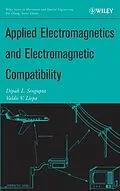Applied Electromagnetics and Electromagnetic Compatibility deals with Radio Frequency Interference (RFI), which is the reception of undesired radio signals originating from digital electronics and electronic equipment. With today's rapid development of radio communication, these undesired signals as well as signals due to natural phenomena such as lightning, sparking, and others are becoming increasingly important in the general area of Electro Magnetic Compatibility (EMC). EMC can be defined as the capability of some electronic equipment or system to be operated at desired levels of performance in a given electromagnetic environment without generating EM emissions unacceptable to other systems operating in the vicinity.
Autorentext
DIPAK L. SENGUPTA, PhD, is Professor Emeritus and Research Scientist at the Radiation Laboratory, Department of Electrical Engineering and Computer Science, University of Michigan, Ann Arbor. He is a Life Fellow of IEEE, and his professional interests are in the areas of antennas, electromagnetics, electromagnetic compatibility, and navigation systems.
VALDIS V. LIEPA, PhD, is a Research Scientist at the Radiation Laboratory, Department of Electrical Engineering and Computer Science, University of Michigan, Ann Arbor, where he works on problems relating to applied electromagnetics and EMC compliance. Dr. Liepa is a Life Member of IEEE.
Klappentext
Tools for understanding and design for EMC
With tighter regulation of electromagnetic emissions, the electronics industry is increasingly looking for professionals with a solid understanding of electromagnetic compatibility (EMC).
The IEEE also encourages engineering schools to include EMC as a course topic. In response to this rising need and demand, the authors have developed a textbook based on their extensive experience in teaching and measurements for EMC compliance.
This textbook skillfully integrates the fundamentals of fields and waves, transmission lines and antennas, and examples in applied electromagnetics, along with a variety of other topics essential to the understanding of EMC. Presentations of electromagnetics are given in the context of EMC; discussions of EMC itself are tailored to assist in analysis and design, as well as planning of measurements for EMC compliance.
Chapter 1 introduces readers to electromagnetic interference and describes the evolution of EMC in the digital electronics era. Following, the authors build on basic concepts and demonstrate their application to the design of electronic devices that perform compatibly in given electromagnetic environments. Topics covered provide a mix of theory and practical problem solving:
- The Electromagnetic Environment
- Fundamentals of Fields and Waves
- Signal Waveform and Spectral Analysis
- Transmission Lines
- Antennas and Radiation
- Behavior of Circuit Components
- Radiated Emissions and Susceptibility
- Electromagnetic Shielding
- Coupling Between Devices
- Electrostatic Discharge
- EMC Standards
- Measurement of Emissions
Most chapters conclude with problem sets that test readers' knowledge and ensure that they have mastered the key concepts. References provided with each chapter enable readers to explore specific topics in greater depth.
This textbook is recommended for senior undergraduate and graduate courses. Additionally, it is an excellent reference for basic electromagnetics and EMC.
Inhalt
Preface xvii
Acknowledgments xxi
1 General Considerations 1
2 The Electromagnetic Environment 9
3 Fundamentals of Fields and Waves 21
4 Signal Waveform and Spectral Analysis 117
5 Transmission Lines 139
6 Antennas and Radiation 195
7 Behavior of Circuit Components 285
8 Radiated Emissions and Susceptibility 335
9 Electromagnetic Shielding 351
10 Coupling between Devices 365
11 Electrostatic Discharge (ESD) 377
12 EMC Standards 391
13 Measurements of Emission 399
Appendix A: Vectors and Vector Analysis 411
Appendix B: Frequency Band Designations 467
Appendix C: Constitutive Relations 473
Index 479
